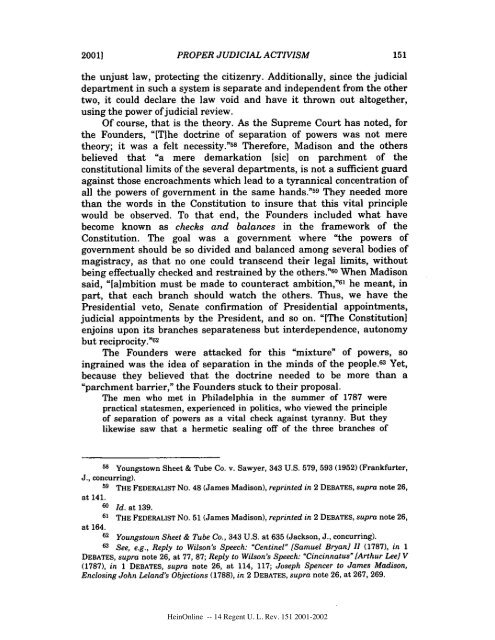Judicial ReEngineering
Judicial ReEngineering
Judicial ReEngineering
You also want an ePaper? Increase the reach of your titles
YUMPU automatically turns print PDFs into web optimized ePapers that Google loves.
2001]<br />
PROPER JUDICIAL ACTIVISM<br />
the unjust law, protecting the citizenry. Additionally, since the judicial<br />
department in such a system is separate and independent from the other<br />
two, it could declare the law void and have it thrown out altogether,<br />
using the power of judicial review.<br />
Of course, that is the theory. As the Supreme Court has noted, for<br />
the Founders, "[Tihe doctrine of separation of powers was not mere<br />
theory; it was a felt necessity." 58 Therefore, Madison and the others<br />
believed that "a mere demarkation [sic] on parchment of the<br />
constitutional limits of the several departments, is not a sufficient guard<br />
against those encroachments which lead to a tyrannical concentration of<br />
all the powers of government in the same hands." 59 They needed more<br />
than the words in the Constitution to insure that this vital principle<br />
would be observed. To that end, the Founders included what have<br />
become known as checks and balances in the framework of the<br />
Constitution. The goal was a government where "the powers of<br />
government should be so divided and balanced among several bodies of<br />
magistracy, as that no one could transcend their legal limits, without<br />
being effectually checked and restrained by the others." 60 When Madison<br />
said, "[aimbition must be made to counteract ambition," 61 he meant, in<br />
part, that each branch should watch the others. Thus, we have the<br />
Presidential veto, Senate confirmation of Presidential appointments,<br />
judicial appointments by the President, and so on. "[The Constitution]<br />
enjoins upon its branches separateness but interdependence, autonomy<br />
but reciprocity." 62<br />
The Founders were attacked for this "mixture" of powers, so<br />
ingrained was the idea of separation in the minds of the people.63 Yet,<br />
because they believed that the doctrine needed to be more than a<br />
"parchment barrier," the Founders stuck to their proposal.<br />
The men who met in Philadelphia in the summer of 1787 were<br />
practical statesmen, experienced in politics, who viewed the principle<br />
of separation of powers as a vital check against tyranny. But they<br />
likewise saw that a hermetic sealing off of the three branches of<br />
58 Youngstown Sheet & Tube Co. v. Sawyer, 343 U.S. 579, 593 (1952) (Frankfurter,<br />
J., concurring).<br />
59 THE FEDERALIST No. 48 (James Madison), reprinted in 2 DEBATES, supra note 26,<br />
at 141.<br />
60 Id. at 139.<br />
61 THE FEDERALIST No. 51 (James Madison), reprinted in 2 DEBATES, supra note 26,<br />
at 164.<br />
62 Youngstown Sheet & Tube Co., 343 U.S. at 635 (Jackson, J., concurring).<br />
63 See, e.g., Reply to Wilson's Speech: "Centinel"[Samuel Bryan] 11 (1787), in 1<br />
DEBATES, supra note 26, at 77, 87; Reply to Wilson's Speech: "Cincinnatus"[Arthur Lee] V<br />
(1787), in 1 DEBATES, supra note 26, at 114, 117; Joseph Spencer to James Madison,<br />
Enclosing John Leland's Objections (1788), in 2 DEBATES, supra note 26, at 267, 269.<br />
HeinOnline -- 14 Regent U. L. Rev. 151 2001-2002

















